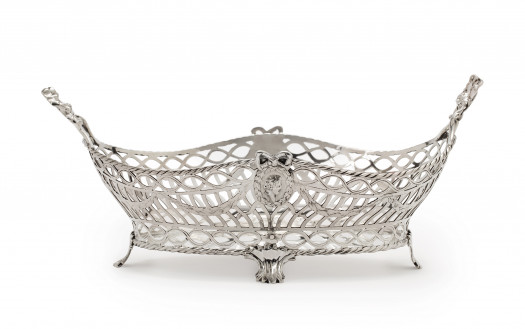Dutch silver bread basket
Jacob J. Roosjen, SRI
DUTCH SILVER BREAD BASKET
Hendrik Nieuwenhuys, Amsterdam, 177
697 grams; 32.2cm long, including handles, 21cm wide, 13.5cm high
The oval bread basket is intricately pierced and decorated with garlands, classical busts in oval medallions, and classical garden vases. The openwork handles are topped with bow ornaments. The basket is elevated on four modeled feet. Fully marked on the underside with an assay stripe on one of the handles at the rim of the basket.
The design of this basket in the neoclassical style, using garlands and ovals with portrait medallions, is rather early. It is possible that the designs of Robert Adam (1728-1792) may have been the source of inspiration. Hendrik Nieuwenhuys is certainly not the first silversmith to use this style. The earliest example in this style may be a silver basket made by his fellow townsman Reinier Brandt in 1774. Johannes Schiotling also made a basket in this style during the same period. Hendrik certainly did not invent the design. His father also worked in this style, as evidenced by a silver basket made in 1777. Similar leaf-shaped feet and garden vases can be found in it. However, the difference is that both Brandt and Schiotling, as well as Harmanus Nieuwenhuys, his father, applied the ornaments, whereas Hendrik engraved the garlands and garden vases on the basket. All baskets by these silversmiths from Amsterdam have similar leaf-shaped feet. Hendrik certainly had learned the trade in his father's workshop. After the death of his father Harmanus Nieuwenhuys on October 25, 1763, Hendrik continued his father's silversmithing business. It was his father's wish, as described in his will, "that upon his death his affairs shall be continued by his eldest son, Hendrik Nieuwenhuys...". Hendrik became a citizen of Amsterdam on November 1, 1763, and presumably also became a registered master silversmith at the guild around the same time. The attribution of the master's mark HN monogram in the outline of a house is telling: the initials and the shape of a house refer to his name. In 1767, Hendrik married Margaretha Johanna, daughter of Jacobus des Ruelles and Maria Kok. Like his father, he probably worked for the firm Peirolet, retailers in Amsterdam. In 1786, Hendrik Nieuwenhuys himself was listed as a shopkeeper. In 1799, this firm was located on Cloveniers Burgwal near Nieuwmarkt in 't Gekroonde Cromhout. As a prolific craftsman, several silver objects made by him are known, such as trays, candlesticks, tobacco jars, teapots, and baskets. Hendrik was related to several Amsterdam silversmiths, such as Benten, Verschuur, and Van Wijk.
Associate literature:
-K.A. Citroen, Amsterdamse zilversmeden en hun merken, Amsterdam, 1975
-J. R. de Lorm, Amsterdams Goud en Zilver, Zwolle, 1999, pp. 523 en 537






